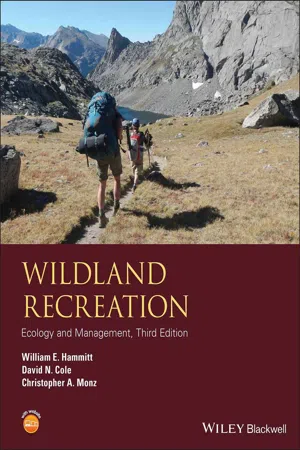
Wildland Recreation
Ecology and Management
- English
- ePUB (mobile friendly)
- Available on iOS & Android
About this book
THE AUTHORITATIVE GUIDE TO UNDERSTANDING AND MANAGING THE ECOLOGICAL IMPACTS OF RECREATIONAL ACTIVITIES IN WILDLANDS
This third edition provides an updated and thorough examination of the ecological impacts of recreational use on wildlands and the best management practices to employ in places where recreation and preservation of natural conditions are important – and often conflicting – objectives.
Covering the latest research, this edition provides detailed information about the environmental changes that result from recreational use. It describes spatial patterns of impact and trends over time, and then explores the factors that determine the magnitude of impact, including the amount of use, the type and behavior of use, and the environmental durability. Numerous examples, drawn from parks and recreation areas around the world, give readers an insight into why certain areas are more heavily damaged than others, and demonstrate the techniques available to mitigate damage.
The book incorporates both the first-hand experience of the authors and an exhaustive review of the world's literature on the subject. Boxes provide quick access to important material, and further resources are referenced in an extensive bibliography. Essential reading for all park and protected area management professionals, this book is also a useful textbook for upper division undergraduate and graduate students on recreation ecology and recreation management courses.
Frequently asked questions
- Essential is ideal for learners and professionals who enjoy exploring a wide range of subjects. Access the Essential Library with 800,000+ trusted titles and best-sellers across business, personal growth, and the humanities. Includes unlimited reading time and Standard Read Aloud voice.
- Complete: Perfect for advanced learners and researchers needing full, unrestricted access. Unlock 1.4M+ books across hundreds of subjects, including academic and specialized titles. The Complete Plan also includes advanced features like Premium Read Aloud and Research Assistant.
Please note we cannot support devices running on iOS 13 and Android 7 or earlier. Learn more about using the app.
Information
Part I
INTRODUCTION
Chapter 1
WILDLAND RECREATION AND RESOURCE IMPACTS
1.1 WHAT IS WILDLAND RECREATION?
stems from the Latin recreatio, which refers to restoration or recovery. The term implies the renewal of energy and mental alertness or the restoration of ability to function. Recreation contains the concept of restoration of wholeness of mind, spirit, and body. It presupposes some other activity that depletes, tires, or deteriorates that wholeness.
Box 1.1 Recreation: a restorative process.


Box 1.2 Wildland recreation versus ecotourism
Table of contents
- Cover
- Title page
- Copyright page
- PREFACE
- Part I: INTRODUCTION
- Part II: IMPACTS TO RESOURCE COMPONENTS
- Part III: IMPACT PATTERNS AND TRENDS
- Part IV: FACTORS AFFECTING IMPACTS
- Part V: MANAGEMENT ALTERNATIVES
- Part VI: CONCLUSION
- INDEX
- ACCESS THE COMPANION WEBSITE
- END USER LICENSE AGREEMENT